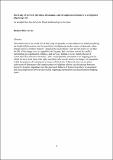Files in this item
Our Lady of Ipswich : devotion, dissonance, and the agitation of memory at a forgotten pilgrimage site
Item metadata
| dc.contributor.author | Irvine, Richard D.G. | |
| dc.date.accessioned | 2020-04-13T23:32:18Z | |
| dc.date.available | 2020-04-13T23:32:18Z | |
| dc.date.issued | 2018-05-01 | |
| dc.identifier | 257429877 | |
| dc.identifier | 0a76a557-4a26-4a4b-8846-833635551c59 | |
| dc.identifier | 85045380577 | |
| dc.identifier.citation | Irvine , R D G 2018 , ' Our Lady of Ipswich : devotion, dissonance, and the agitation of memory at a forgotten pilgrimage site ' , Journal of the Royal Anthropological Institute , vol. 24 , no. 2 , pp. 366-384 . https://doi.org/10.1111/1467-9655.12815 | en |
| dc.identifier.issn | 1359-0987 | |
| dc.identifier.other | ORCID: /0000-0003-0468-4510/work/90112680 | |
| dc.identifier.uri | https://hdl.handle.net/10023/19795 | |
| dc.description.abstract | This article traces the social life of Our Lady of Ipswich, a statue taken to be destroyed during the English Reformation, and the possibility of pilgrimage in the context of dramatic urban change and loss of place memory. Arguing that iconoclasm is not an end-point, we see that the life of the image is not extinguished on the pyre, but is set into motion by conflict surrounding its significance, efficacy, and survival. Indeed, it is not simply the act of iconoclasm that animates the statue; rather, such agonistic animation is an ongoing process which involves both those who reject and those who are devoted to the image. My argument is that the potency of contemporary images of Our Lady of Ipswich relies on an active cultivation of dissonance: the consciousness of religious schism; the disjuncture between Ipswich's historical importance and the perceived failures of twentieth-century development; and the juxtaposition between devotional pilgrimage destination and disenchanted shopping space. | |
| dc.format.extent | 19 | |
| dc.format.extent | 403983 | |
| dc.language.iso | eng | |
| dc.relation.ispartof | Journal of the Royal Anthropological Institute | en |
| dc.subject | GN Anthropology | en |
| dc.subject | Anthropology | en |
| dc.subject | Arts and Humanities (miscellaneous) | en |
| dc.subject | NDAS | en |
| dc.subject | BDC | en |
| dc.subject | R2C | en |
| dc.subject.lcc | GN | en |
| dc.title | Our Lady of Ipswich : devotion, dissonance, and the agitation of memory at a forgotten pilgrimage site | en |
| dc.type | Journal article | en |
| dc.contributor.institution | University of St Andrews. Social Anthropology | en |
| dc.identifier.doi | https://doi.org/10.1111/1467-9655.12815 | |
| dc.description.status | Peer reviewed | en |
| dc.date.embargoedUntil | 2020-04-14 | |
| dc.identifier.url | http://oro.open.ac.uk/id/eprint/53909 | en |
This item appears in the following Collection(s)
Items in the St Andrews Research Repository are protected by copyright, with all rights reserved, unless otherwise indicated.

